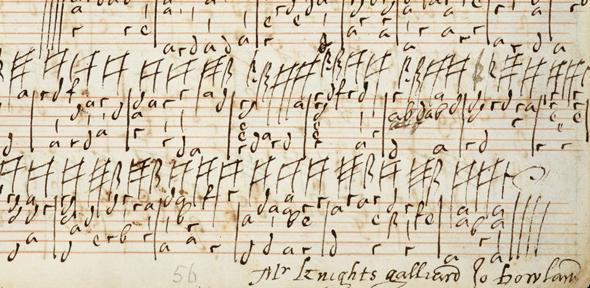The following has reached us from the University of Cambridge (CC BY-NC-SA):

Handwritten copies of scores by composers of English lute music have been digitised in a programme to make a precious legacy available to professional and amateur musicians around the world.
Cambridge Digital Library is launching a new Music Collection with the online release of the 'crown jewels' of English lute music. Dating from the late 16th and early 17th century, the manuscripts contain handwritten copies of scores by John Dowland, Francis Cutting and dozens of other early modern composers.
Digital versions of the manuscripts went online 11 December 2014 as the first items in a new digital Music Collection, which will grow to reflect Cambridge University Library's important holdings in this area. The Library’s holdings range from music scores and texts on music to ephemera and concert programmes to archival materials documenting the life and work of composers. Such items play a crucial role in the preservation of musical heritage on a national and international level.
The new online collection of lute music comprises high-resolution zooming images of around 650 pieces contained in eight manuscripts, allowing full access to these unique items to anyone with an internet connection. Pieces from the collection range from celebratory jigs and dances, to popular ballads and sorrowful music for funerals, giving an extraordinary insight into the role and uses of music in early modern England.
The digitisation has been created in collaboration with the Lute Society. The images are accompanied by scholarly descriptions of the manuscripts’ physical properties and inventories of their contents. Four of the eight manuscripts were handwritten by Mathew Holmes, choirmaster at Westminster Abbey until 1621.
The hundreds of pieces, crammed into more than 600 pages, preserve a cross-section of the lute repertoire in common use in England during the period 1580-1615, the ‘Golden Age’ of English lute music. Together they form the leading source for the music of the best-known lute composers from the English Renaissance. The manuscripts shed light on the Tudor celebrities to whom some of the pieces are dedicated - from the courtier Sir Walter Raleigh to the Shakespearean actor Will Kemp.
John Robinson of the Lute Society commented: “A huge number of manuscripts have been lost over the centuries, which makes the survival of this collection all the more remarkable. Today it is an invaluable legacy for professional musicians and musicologists as well as amateur enthusiasts. Digitisation means that the original sources of lute music can be viewed, studied and played by people worldwide.”
Also digitised are personal items. Shown online for the first time is the lute book of an English government official which remained in his family for over 350 years, and a manuscript painstakingly reassembled from fragments cut up and used in the bindings of later printed books.
The European lute was probably derived from the Arabic Ud and was one of the most important musical instruments during the Middle Ages and Renaissance. The first lute music to have been written down dates from the late 15th century. English Tudor court musicians included paid lutenists. Learning the lute was an important part of the education of royalty and nobility.
The 1580s onwards saw the emergence of composers who developed the characteristically English lute music that flourished into the second decade of the 17th century. Among them are John Johnson, Francis Cutting, Anthony Holborne, Daniel Bacheler, John Dowland and Robert Johnson. This crucial period in English lute music coincides with the copying of the Cambridge lute manuscripts.
Robinson said: “The manuscripts are written in French tablature with the notation providing a guide to where to put the fingers on the lute neck, rather like chord shapes in modern guitar tutors. Nearly all the music is for Renaissance lute which is tuned as a guitar except the third string is a semitone lower on the lute. The unfamiliarity with tablature notation led to lute sources being largely excluded from mainstream musicology. Now both amateurs and professionals are taught to read it and generally prefer to sight read tablature, especially from copies of original sources.”
In putting this magnificent collection online, Cambridge University Library is not only making the manuscripts available to the existing international community of lute enthusiasts, but also reaching new audiences. Anne Jarvis, Cambridge University Librarian, said: “We are delighted to have had the opportunity to work with the Lute Society to put these unique manuscripts online as the first documents in our new Music Collection.”
Cambridge Digital Library’s new Music Collection is being launched with a private recital at the University of Cambridge by one of the world’s leading lutenists, Jakob Lindberg, who will be performing pieces found in these recently digitised manuscripts.
- Facebook Like
- Share on Facebook
- Log in to post comments

